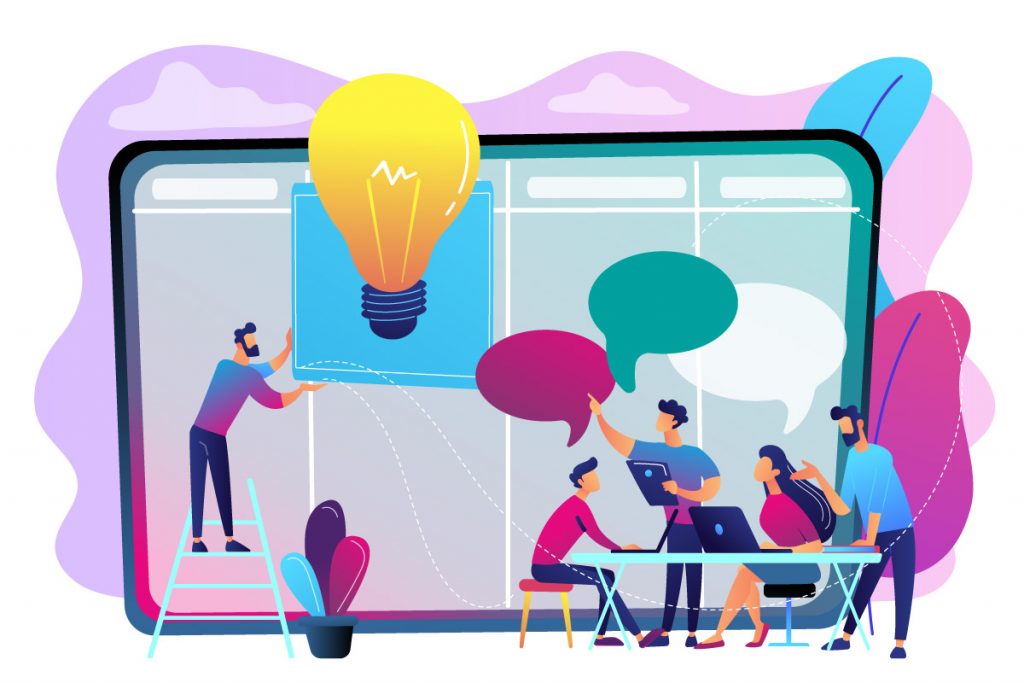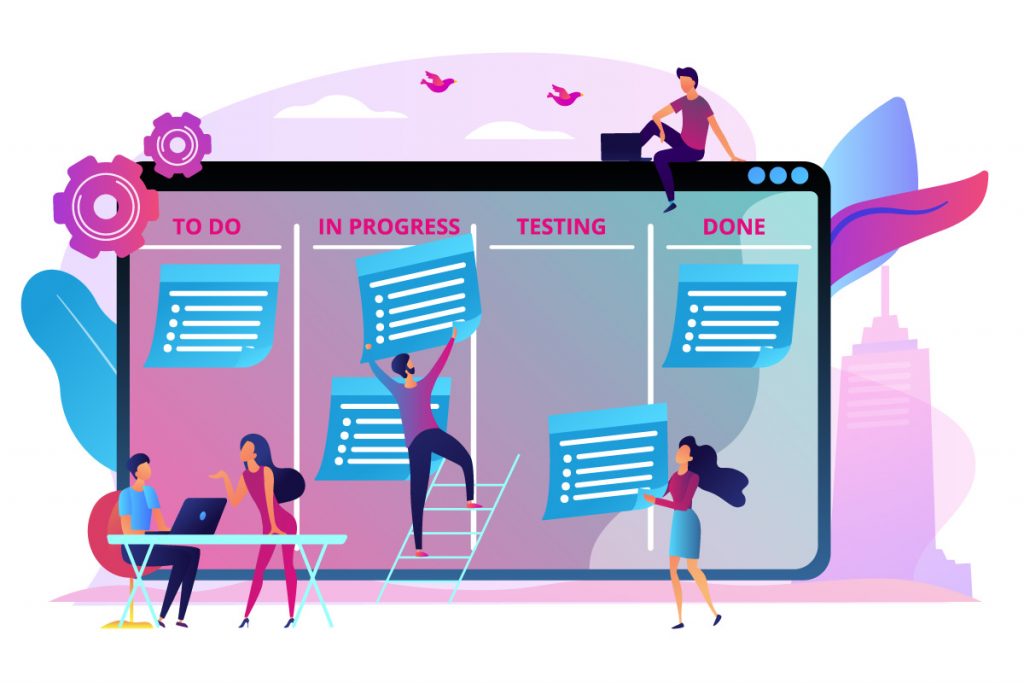Blended Learning: In 5 Schritten zum gelungenen Schulungskonzept
Üblicherweise versteht man unter dem Begriff Blended Learning die Kombination einer digitalen Lehrmethode mit einer Präsenzschulung.
Welchen Anteil dabei welches Schulungsformat einnimmt und welche Formate genutzt werden, hängt von vielen Faktoren ab.
Mit diesem Artikel möchte ich Ihnen eine Orientierungshilfe geben, wie Sie für Ihr Vorhaben, die Schulungsformate optimal zusammenstellen und so ein gelungenes Blended Learning Konzept entwickeln.
Sehr häufig spielen äußere Faktoren bei der Auswahl der Formate eine Rolle. Bei einer Schulung für eine globale Organisation, bei der die Lernenden weit verstreut sind, gibt es üblicherweise eine Regelung, wieviel Zeit für eine Präsenzveranstaltung zur Verfügung steht. Wird das Blended Learning Schulungskonzept dagegen in einer Universität genutzt, so kann auch der Anteil an Präsenzveranstaltungen überwiegen.
Grundsätzlich ist Blended Learning aber immer dann am wirksamsten, wenn der Mix durch die Zielgruppe, das Lernziel und die Nutzung des jeweils besten Formats für die entsprechenden Zwischenziele bestimmt wird. Starten Sie deshalb immer mit Schritt 1.
Schritt 1: Legen Sie die Zielgruppe und Lernziele fest
Legen Sie zunächst Ihre Zielgruppe und Ihr Lernziel fest. Planen Sie ein komplexeres Programm, wie beispielsweise ein Onboarding, sollten Sie unbedingt auch Zwischenziele festlegen.
Tipp: Nehmen Sie schon bei diesem Schritt alle Stakeholder mit, so werden Sie es später leichter haben, Ihr Programm zu etablieren.
Schritt 2: Entscheiden Sie sich für die optimalen Schulungsformate
Um die optimalen Formate für Ihr Schulungsvorhaben zu finden und zusammenzustellen, müssen wir zunächst einen Blick auf die Auswahl werfen. Dazu stelle ich Ihnen kurz die gängigsten Schulungsformate mit ihren Anwendungsmöglichkeiten ![]() und Vorteilen
und Vorteilen ![]() vor.
vor.
Formate für das Selbststudium:
Video

Für den Lernenden sind Videos attraktiv, weil sie durch die Immersion mehr Emotionen erzeugen als andere digitale Lernformate. Dies führt zu einem hohen Erinnerungswert des Gelernten und ermöglicht sogar Einstellungs- oder Verhaltensänderungen. Limitierend bei diesem Format ist die fehlende Interaktion. Das führt zu einer relativ kurzen Aufmerksamkeitsspanne. Ich würde Videos daher nicht für sehr komplexe Themen empfehlen oder diese in mehrere Einzelvideos aufteilen.
Web Based Trainings (WBTs)

Web Based Trainings ermöglichen es, Erzähltes mit Interaktionen zu kombinieren. Komplexe Sachverhalte können in Wort und Bild erklärt und das Wissen dann in einem Quiz angewendet werden. So entsteht eine große Lerntiefe. Ich schlage dieses Format für Themen vor, die komplex sind, aber auch für die Themen, bei denen eine Einstellungs- oder Verhaltensänderung angestrebt wird.
Audio Learning

Audio Learning, beispielsweise ein Podcast, hat den Vorteil, dass die Lernenden nahezu überall (auch wenn sie selbst ein Fahrzeug lenkt) darauf zurückgreifen können. Audioformate können ähnlich lang wie WBTs sein. Ich empfehle dieses Format für Diskurse wie Diskussionen oder Pro- und Kontraformate.
Texte

Texte können zum einen gedruckte Texte wie Bücher, aber auch PDFs, E-Books oder Webseiten sein. Sie haben den Vorteil, dass sie leicht zugänglich gemacht werden können, es gibt wenig technische Voraussetzungen. Darüber hinaus sind Texte verhältnismäßig schnell zu erstellen und bieten so eine schnelle Möglichkeit der Wissensvermittlung. Dabei können Wort und Bild verwendet werden, um Zusammenhänge darzustellen. Insbesondere Bücher können dabei große Mengen an Wissen vermitteln.
Formate für das Selbststudium und das gemeinsame Studium:
Rechercheaufgaben

Rechercheaufgaben können an einzelne Teilnehmer oder Teams vergeben werden. Materialien sind optional. Aufgaben haben den Vorteil, dass sich die Teilnehmer intensiv mit dem Thema auseinandersetzen müssen. Gleichzeitig wird ihre Recherchekompetenz gestärkt. Wenn die Bearbeitung im Team erfolgt, führen Aufgaben zu einem größeren Zusammenhalt in der Teilnehmerschaft. Für die Präsentation der Ergebnisse können unterschiedliche Formate verwendet werden. So stärken Sie auch hier gezielt weitere Kompetenzen.
Tipp: Stehen Sie für Rückfragen und Hilfestellungen zur Verfügung. Hierfür rate ich Ihnen, ein Forum / eine Plattform für die Erarbeitung und die Präsentation des Erarbeiteten zu nutzen.
On the job Training (OTJ)

On the job Trainings können direkt im tatsächlichen Arbeitsumfeld angesiedelt sein. Sie können aber auch Simulationsaufgaben unter Realbedingungen der späteren Aufgabe sein. In jedem Fall vertiefen sie das Gelernte und zeigen den Unterschied zwischen Theorie und Praxis. Denn theoretisches Wissen bedeutet nicht automatisch, dass es in der Praxis auch angewendet werden kann.
Formate für das gemeinsame Studium:
Präsenzveranstaltung

Präsenzveranstaltungen sollten in einem Blended Learning Schulungskonzept sehr gezielt für Aktivitäten und Übungen eingesetzt werden. Zusätzlich sollten die Möglichkeiten durch die direkte Ansprache des Lehrenden genutzt werden. Moderierte Gruppenarbeiten zur Ausarbeitung von Lösungsansätzen können beispielsweise zur Lernvertiefungen eingesetzt werden.
Präsenzveranstaltungen bieten Lerngruppen, zum Beispiel in gemeinsamen Pausen, die Möglichkeit, sich auch informell kennenzulernen. Dieser Effekt kann durch Übungen mit sozialer Interaktion oder wechselnde Kleingruppen noch verstärkt werden.
Webinare

In Webinaren haben Sie ähnlich viele Optionen wie in der Präsenzveranstaltung. Je nach Webinartool stehen Ihnen vielfältige Interaktionsmöglichkeiten zur Verfügung. Durch Diskussionen, direkte Ansprache des Lehrenden, Whiteboards, Polls, Chats und die Bildung von Kleingruppen, lässt sich ein hohes Maß an Interaktion und eine große Lerntiefe erreichen.
Im Vergleich zu Präsenzveranstaltungen haben Webinare allerdings einige Nachteile: So sieht man die Körpersprache des Lehrenden sowie der Lerner nicht (es sei denn, man hat die Möglichkeit mit Webcams zu arbeiten). Darüber hinaus ergibt sich ein informeller Austausch nur schwer.
Formate, die alles zusammenhalten und der Vertiefung dienen:
Social Learning Plattform
Eine Social Learning Plattform fungiert als zentraler Anlaufort für Selbstlernphasen und Kooperationen außerhalb des Präsenztrainings. Hier treffen sich die Teilnehmer, finden zum Beispiel ihre nächsten Aufgaben und Hilfestellungen, haben die Möglichkeit Fragen zu stellen und sich miteinander und mit dem Lehrenden auszutauschen. So fühlt sich das Blended Learning Schulungskonzept wie aus einem Guss an und die Teilnehmer fühlen sich auch in den Selbstlernphasen nicht allein gelassen.
Alternativen zu einer Social Learning Plattform
Natürlich können Sie für diese Phasen bei größeren Blended Learning Programmen auch andere Möglichkeiten des Supports und der Vertiefung wie Tutoren, Mentoren, Vorgesetzte oder Personalentwickler nutzen. Newsletter können auch hilfreich sein.
Haben Sie für Ihr Lernziel und Ihre Zielgruppe die Formate identifiziert, die Ihnen die optimalen Ergebnisse liefern?
Schritt 3: Stellen Sie Ihr Programm zusammen
Ordnen Sie nun die verschiedenen Formate so zu einem Programm zusammen, wie sie idealerweise aufeinanderfolgen würden ohne weitere Faktoren miteinzubeziehen. Bedenken Sie diese in einem zweiten Schritt.
Weitere Faktoren, die die Zusammenstellung Ihres Programms beeinflussen könnten:
- Logistik: Lässt sich das Programm logistisch optimieren? Sollten Präsenzzeiten am Stück oder aufgeteilt sein?
- Flexibilität: Wie groß ist die zeitliche Flexibilität einzelner Bausteine? Welche anderen Formate wären denkbar?
- Selbstbestimmt: Können Teile des Programms in unterschiedlichen Schulungsformaten zur Verfügung gestellt werden? Oder ist die zeitliche Abfolge mancher Bausteine beliebig? Dann sollten die Lerner selbst entscheiden, welches Format oder welche Reihenfolge sie wählen. Das gibt Ihnen Kontrolle und erhöht so ihre Motivation.
- Synergien: Gibt es die Möglichkeit beispielsweise schon vorhandene Programme zu nutzen und so Ihr Vorhaben effizienter zu gestalten?
Schritt 4: Prüfen Sie die Machbarkeit Ihres Blended Learning Schulungskonzeptes
Bevor Sie nun mit der Umsetzung starten, prüfen Sie zunächst die Machbarkeit Ihres Konzeptes in Ihrer Organisation:
- Hat Ihre Zielgruppe die Ressourcen, die sie für dieses Programm braucht? Hat sie die Zeit und das nötige Equipment für die Teilnahme?
- Verfügt Ihre Zielgruppe über die Kompetenzen, die sie benötigt, um an Ihrem Programm teilzunehmen? Kann sie z. B. mit einer Lernplattform umgehen?
- Stehen Ihnen das Equipment und die Software zur Verfügung, die Sie für Ihr Schulungskonzept benötigen? Oder können Sie dieses anschaffen?
- Bekommen Sie die Ressourcen beispielsweise Arbeitszeiten von Teilnehmern und benötigten Abteilungen für das on the job Training, Budget für externe Leistungen, Expertise zu bestimmten Themen oder Trainingszeiten von Ihrer Organisation? Hierfür brauchen Sie unbedingt eine realistische Berechnung.
Tipp: Suchen Sie sich für Ihr Vorhaben Unterstützung in der Chefetage (Executive Sponsor). - Verfügt Ihre Organisation über eine passende Weiterbildungskultur, d. h. ist es realistisch, dieses Blended Learning Konzept mit festgelegtem Zeitplan und Aufwand durchzuführen?
Sollten Sie bei der Machbarkeitsprüfung zu dem Schluss kommen, dass Teile Ihres Schulungskonzeptes so nicht umsetzbar sind, justieren Sie nach. Manchmal ist die zweitbeste Lösung besser als keine.
Schritt 5: Evaluieren Sie Ihr Konzept
Haben Sie Ihr Blended Learning Schulungskonzept zusammengestellt, vergessen Sie nicht, es auch zu evaluieren. So können Sie zum einen nachjustieren, wenn ein Teil Ihres Programms nicht so hilfreich oder erfolgreich ist. Zum anderen haben Sie die Möglichkeit, Ihrem Management Zahlen vorzulegen, die es davon überzeugen werden, dass sich die Investition in Ihr Programm lohnt.
Fazit
Blended Learning ist viel mehr als nur das Auslagern einzelner Präsenzveranstaltungen in E-Learnings. Ihre Organisation muss über die passende Weiterbildungskultur und -infrastruktur verfügen, Ihr Konzept aus den passenden Bausteinen bestehen. Bedenken Sie, dass eine gute Betreuung der Lernenden auch während der Schulungsmaßnahme erforderlich sein kann.
Beachten Sie aber all das, erhalten Sie den richtigen Mix ür einen nachhaltigen Erfolg. Die Lernenden sind nach Abschluss Ihres Blended Learning Schulungskonzeptes leistungsfähiger als Teilnehmer einer reinen Präsenz- oder E-Learning-Intervention.
Wünschen Sie eine weitergehende individuelle Beratung?
Dann kontaktieren Sie uns gerne!
Möchten Sie weitere Informationen zu Schulungskonzepten?
Dann bleiben Sie unserem Blog treu, denn wir planen weitere Posts, in denen wir andere Konzepte genauer vorstellen.
Haben Sie Fragen oder Erfahrungen mit Blended Learning Schulungskonzepten?
Dann teilen Sie sie mit uns in den Kommentaren! Ganz herzlichen Dank!



